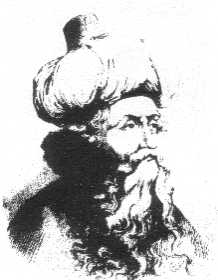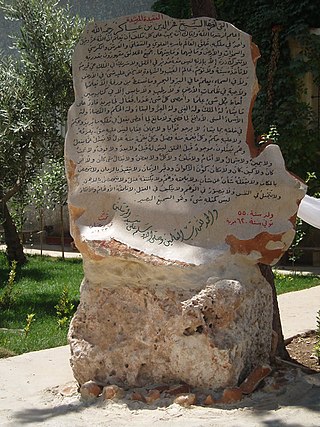
Ibn ʿArabī was an Andalusi Arab scholar, mystic, poet, and philosopher, extremely influential within Islamic thought. Out of the 850 works attributed to him, some 700 are authentic while over 400 are still extant. His cosmological teachings became the dominant worldview in many parts of the Muslim world.
Ilm al-kalam or ilm al-lahut, often shortened to kalam, is the scholastic, speculative, or rational study of Islamic theology (aqida). It can also be defined as the science that studies the fundamental doctrines of Islamic faith, proving their validity, or refuting doubts regarding them. Kalām was born out of the need to establish and defend the tenets of Islam against the philosophical doubters. A scholar of kalam is referred to as a mutakallim, a role distinguished from those of Islamic philosophers and jurists.

Yahya ibn Sharaf al-Nawawi (Arabic: يحيى بن شرف النووي, romanized: Yaḥyā ibn Sharaf al-Nawawī; was a Sunni Shafi'ite jurist and hadith scholar. Al-Nawawi died at the relatively early age of 45. Despite this, he authored numerous and lengthy works ranging from hadith, to theology, biography, and jurisprudence that are still read to this day. Al-Nawawi, along with Abu al-Qasim al-Rafi'i, are leading jurists of the earlier classical age, known by the Shafi'i school as the Two Shaykhs.
Muhammad bin Ahmed bin Juzayy Al Gharnati, better known as Ibn Juzayy was an Andalusian Sunni Muslim scholar of Arab origin. He was a distinguished Maliki jurist, legal theoretician, Quran commentator, Quran reciter, hadith scholar, historian, scholar in Arabic, poet, preacher, orator, and a literary figure. He achieved notoriety at a young age, known as a major scholar of his day. He is famed for authoring classical works and for achieving martyrdom during his jihad against the Spanish Christian crusade.
Shams ad-Dīn adh-Dhahabī, also known as Shams ad-Dīn Abū ʿAbdillāh Muḥammad ibn Aḥmad ibn ʿUthmān ibn Qāymāẓ ibn ʿAbdillāh at-Turkumānī al-Fāriqī ad-Dimashqī was an Athari theologian, Islamic historian and Hadith scholar.

The Muwaṭṭaʾ or Muwatta Imam Malik of Imam Malik (711–795) written in the 8th-century, is one of the earliest collections of hadith texts comprising the subjects of Islamic law, compiled by the Imam, Malik ibn Anas. It is also the earliest extant example of a musannaf, referring to a genre of hadith compilation which arranges hadith topically.

Aḥmad ibn Muḥammad ibn ʿAjība al-Ḥasanī was an influential 18th-century Moroccan scholar and poet in the Sunni Darqawa Sufi lineage.

Shihāb al-Dīn Abu'l-‘Abbās Aḥmad ibn Muḥammad ibn Abī Bakr al-Qasṭallānī al-Qutaybī al-Shāfi‘ī, also known as Al-Qasṭallānī was a Sunni Islamic scholar who specialized in hadith and theology. He owed his literary fame mainly to his exhaustive commentary on the Sahih al-Bukhari entitled Irshād al-Sarī fī Sharḥ al-Bukhārī.
Abū Bakr Muḥammad ibn al-Ṭayyib al-Bāqillānī, was a Sunni Muslim scholar and polymath who specialized in speculative theology, jurisprudence, logic, and hadith. He spent much of his life defending and strengthening the Ash'ari school of theology within Islam. An accomplished rhetorical stylist and orator, al-Baqillani was held in high regard by his contemporaries for his expertise in debating theological and jurisprudential issues. Al-Dhahabi referred to him as "the learned imam, incomparable master, foremost of the scholars, author of many books, and example of articulateness and intelligence."
Ibn Abī Zayd (922–996), fully Abū Muḥammad ʿAbd Allāh ibn Abī Zayd ʿAbd al-Raḥmān al-Nafzawī ibn Abī Zayd al-Qayrawanī, was a Maliki scholar from Kairouan in Tunisia and was also an active proponent of Ash'ari thought. His best known work is Al-Risala or the Epistle, an instructional book devoted to the education of young children. He was a member of the Nafzawah Berber tribe and lived in Kairouan. In addition, he served as the Imam of one of the mosques' that followed the Maliki School tradition.

Al-'Aqida al-Tahawiyya or Bayan al-Sunna wa al-Jama'a is a popular exposition of Sunni Muslim doctrine written by the tenth-century Egyptian theologian and Hanafi jurist Abu Ja'far al-Tahawi.
Najm ad-Dīn Abū Ḥafṣ 'Umar ibn Muḥammad an-Nasafī was a Muslim jurist, theologian, mufassir, muhaddith and historian. A Persian scholar born in present-day Uzbekistan, he wrote mostly in Arabic.

Ibrāhīm ibn Muḥammad ibn Aḥmad al-Šāfiʿī al-Bājūrī (1784-1860) was an Egyptian-Ottoman scholar, theologian and a dean of the al-Azhar University. A follower of Imam Al-Shafiʽi, he authored over 20 works and commentaries in sacred law, tenets of faith, Islamic estate division, scholastic theology, logic and Arabic.
Ibrahim al-Laqqani was a mufti of Maliki law, a scholar of Hadith, a scholar of theology and author of one of the most popular didactic poems on Ash'ari theology which became the subject of numerous commentaries and glossaries. One such was by his son 'Abd al-Salam al-Laqani.

Ahmad Zayni Dahlan (1816–1886) was the Grand Mufti of Mecca between 1871 and his death. He also held the position of Shaykh al-Islam in the Hejaz and Imam al-Haramayn. Theologically and juridically, he followed the Shafi'i school of thought.

Abū Isḥāq Ibrāhīm ibn ʿAlī al-Shīrāzī was a prominent Persian jurisconsult, legal theoretician, theologian, debater and muhaqqiq (researcher). He was one of the leading scholars of Shafiʿi jurisprudence in the eleventh century and arguably the most prolific writer of Islamic legal literature.

Al-Risala al-Qushayriyya fi 'Ilm al-Tasawwuf, mostly known as al-Risala al-Qushayriyya, is one of the early complete manuals of the science of Sufism, written by the Shafi'i-Ash'ari scholar Abu al-Qasim al-Qushayri. It was written in 438/1045–6 and has been published in several editions and translated in various languages, including English, French, German, Persian, Turkish, and Urdu. It became the most widely disseminated handbook of Sufism in the Islamic world.

Sharh al-'Aqa'id al-Nasafiyya is a commentary written by the Hanafi-Shafi'i scholar al-Taftazani on the creed of Najm al-Din 'Umar al-Nasafi, an authoritative compendium on Islamic Sunni theology that remained a standard textbook in Ottoman schools. The book is a commentary on al-Nasafi's treatise, in which al-Nasafi systematized Hanafi-Maturidi theology. However, al-Taftazani adopted an Ash'ari perspective in his commentary.
Tanbih al-Ghabi bi-Tabri'at Ibn 'Arabi is a booklet written by the Shafi'i-Ash'ari scholar Jalal al-Din al-Suyuti as a response to the book Tanbih al-Ghabi ila Takfir Ibn 'Arabi by Burhan al-Din al-Biqa'i in which al-Suyuti defended Ibn 'Arabi against his critics in general, and against accusations of heresy and unbelief by al-Biqa'i in particular. Al-Suyuti said:
The scholars past and present have differed concerning Ibn 'Arabi, one group considering him a wali of Allah - and they are correct - such as Ibn 'Ata' Allah al-Sakandari and 'Afif al-Din al-Yafi'i, another considering him a heretic - such as a large number of the jurists - while others expressed doubts concerning him, among them al-Dhahabi in al-Mizan. Two opposed verdicts are reported from Shaykh 'Izz al-Din ibn 'Abd al-Salam, one attacking him, and one describing him as the Spiritual Pole (al-Qutb). What reconciles them is indicated by Shaykh Taj al-Din ibn 'Ata' Allah in Lata'if al-Minan, namely, that Shaykh 'Izz al-Din at the beginning acted in the fashion of jurists in passing quick judgment on the Sufis. When Shaykh Abu al-Hasan al-Shadhili went to pilgrimage and returned, he came to Shaykh 'Izz al-Din before entering his own house and conveyed to him the Prophet's ﷺ greeting. After that, Shaykh 'Izz al-Din humbled himself and began to sit in al-Shadhili's gatherings...

![Manuscript of Tuhfat al-Murid [ar] by Ibrahim al-Bajuri (d. 1276/1860) on the Jawharat al-Tawhid ("Jewel of Divine Oneness"), digitized by the Endangered Archives Programme of the British Library Manuscript of Tuhfat al-Murid.jpg](http://upload.wikimedia.org/wikipedia/commons/thumb/a/ad/Manuscript_of_Tuhfat_al-Murid.jpg/220px-Manuscript_of_Tuhfat_al-Murid.jpg)










